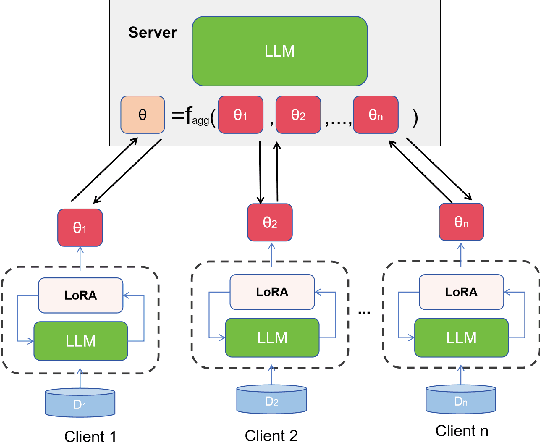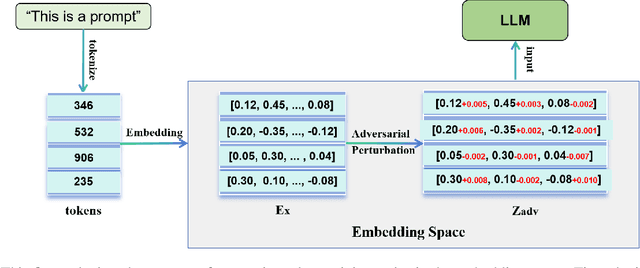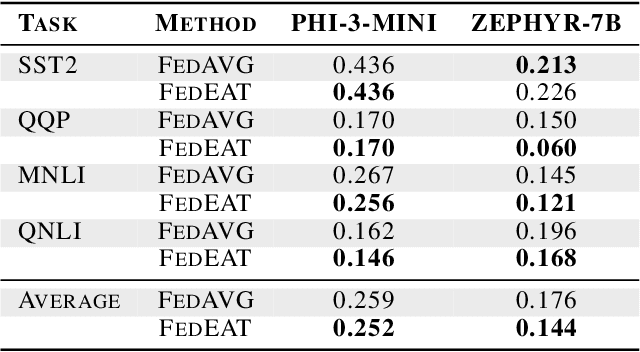Xiaojin Zhang
FedSDAF: Leveraging Source Domain Awareness for Enhanced Federated Domain Generalization
May 05, 2025Abstract:Traditional domain generalization approaches predominantly focus on leveraging target domain-aware features while overlooking the critical role of source domain-specific characteristics, particularly in federated settings with inherent data isolation. To address this gap, we propose the Federated Source Domain Awareness Framework (FedSDAF), the first method to systematically exploit source domain-aware features for enhanced federated domain generalization (FedDG). The FedSDAF framework consists of two synergistic components: the Domain-Invariant Adapter, which preserves critical domain-invariant features, and the Domain-Aware Adapter, which extracts and integrates source domain-specific knowledge using a Multihead Self-Attention mechanism (MHSA). Furthermore, we introduce a bidirectional knowledge distillation mechanism that fosters knowledge sharing among clients while safeguarding privacy. Our approach represents the first systematic exploitation of source domain-aware features, resulting in significant advancements in model generalization capability.Extensive experiments on four standard benchmarks (OfficeHome, PACS, VLCS, and DomainNet) show that our method consistently surpasses state-of-the-art federated domain generalization approaches, with accuracy gains of 5.2-13.8%. The source code is available at https://github.com/pizzareapers/FedSDAF.
FedEM: A Privacy-Preserving Framework for Concurrent Utility Preservation in Federated Learning
Mar 08, 2025Abstract:Federated Learning (FL) enables collaborative training of models across distributed clients without sharing local data, addressing privacy concerns in decentralized systems. However, the gradient-sharing process exposes private data to potential leakage, compromising FL's privacy guarantees in real-world applications. To address this issue, we propose Federated Error Minimization (FedEM), a novel algorithm that incorporates controlled perturbations through adaptive noise injection. This mechanism effectively mitigates gradient leakage attacks while maintaining model performance. Experimental results on benchmark datasets demonstrate that FedEM significantly reduces privacy risks and preserves model accuracy, achieving a robust balance between privacy protection and utility preservation.
FedEAT: A Robustness Optimization Framework for Federated LLMs
Feb 17, 2025



Abstract:Significant advancements have been made by Large Language Models (LLMs) in the domains of natural language understanding and automated content creation. However, they still face persistent problems, including substantial computational costs and inadequate availability of training data. The combination of Federated Learning (FL) and LLMs (federated LLMs) offers a solution by leveraging distributed data while protecting privacy, which positions it as an ideal choice for sensitive domains. However, Federated LLMs still suffer from robustness challenges, including data heterogeneity, malicious clients, and adversarial attacks, which greatly hinder their applications. We first introduce the robustness problems in federated LLMs, to address these challenges, we propose FedEAT (Federated Embedding space Adversarial Training), a novel framework that applies adversarial training in the embedding space of client LLM and employs a robust aggregation approach, specifically geometric median aggregation, to enhance the robustness of Federated LLMs. Our experiments demonstrate that FedEAT effectively improves the robustness of Federated LLMs with minimal performance loss.
InsQABench: Benchmarking Chinese Insurance Domain Question Answering with Large Language Models
Jan 19, 2025Abstract:The application of large language models (LLMs) has achieved remarkable success in various fields, but their effectiveness in specialized domains like the Chinese insurance industry remains underexplored. The complexity of insurance knowledge, encompassing specialized terminology and diverse data types, poses significant challenges for both models and users. To address this, we introduce InsQABench, a benchmark dataset for the Chinese insurance sector, structured into three categories: Insurance Commonsense Knowledge, Insurance Structured Database, and Insurance Unstructured Documents, reflecting real-world insurance question-answering tasks.We also propose two methods, SQL-ReAct and RAG-ReAct, to tackle challenges in structured and unstructured data tasks. Evaluations show that while LLMs struggle with domain-specific terminology and nuanced clause texts, fine-tuning on InsQABench significantly improves performance. Our benchmark establishes a solid foundation for advancing LLM applications in the insurance domain, with data and code available at https://github.com/HaileyFamo/InsQABench.git.
Do Current Video LLMs Have Strong OCR Abilities? A Preliminary Study
Dec 29, 2024



Abstract:With the rise of multimodal large language models, accurately extracting and understanding textual information from video content, referred to as video based optical character recognition (Video OCR), has become a crucial capability. This paper introduces a novel benchmark designed to evaluate the video OCR performance of multi-modal models in videos. Comprising 1,028 videos and 2,961 question-answer pairs, this benchmark proposes several key challenges through 6 distinct subtasks: (1) Recognition of text content itself and its basic visual attributes, (2)Semantic and Spatial Comprehension of OCR objects in videos (3) Dynamic Motion detection and Temporal Localization. We developed this benchmark using a semi-automated approach that integrates the OCR ability of image LLMs with manual refinement, balancing efficiency, cost, and data quality. Our resource aims to help advance research in video LLMs and underscores the need for improving OCR ability for video LLMs. The benchmark will be released on https://github.com/YuHuiGao/FG-Bench.git.
RSL-SQL: Robust Schema Linking in Text-to-SQL Generation
Oct 31, 2024



Abstract:Text-to-SQL generation aims to translate natural language questions into SQL statements. In large language models (LLMs) based Text-to-SQL, schema linking is a widely adopted strategy to streamline the input for LLMs by selecting only relevant schema elements, therefore reducing noise and computational overhead. However, schema linking faces risks that requires caution, including the potential omission of necessary elements and disruption of database structural integrity. To address these challenges, we propose a novel framework called RSL-SQL that combines bidirectional schema linking, contextual information augmentation, binary selection strategy, and multi-turn self-correction. Our approach improves the recall of schema linking through forward and backward pruning and hedges the risk by voting between full schema and contextual information augmented simplified schema. Experiments on the BIRD and Spider benchmarks demonstrate that our approach achieves state-of-the-art execution accuracy among open-source solutions, with 67.2% on BIRD and 87.9% on Spider using GPT-4o. Furthermore, our approach outperforms a series of GPT-4 based Text-to-SQL systems when adopting DeepSeek (much cheaper) with same intact prompts. Extensive analysis and ablation studies confirm the effectiveness of each component in our framework. The codes are available at https://github.com/Laqcce-cao/RSL-SQL.
MC-CoT: A Modular Collaborative CoT Framework for Zero-shot Medical-VQA with LLM and MLLM Integration
Oct 06, 2024



Abstract:In recent advancements, multimodal large language models (MLLMs) have been fine-tuned on specific medical image datasets to address medical visual question answering (Med-VQA) tasks. However, this common approach of task-specific fine-tuning is costly and necessitates separate models for each downstream task, limiting the exploration of zero-shot capabilities. In this paper, we introduce MC-CoT, a modular cross-modal collaboration Chain-of-Thought (CoT) framework designed to enhance the zero-shot performance of MLLMs in Med-VQA by leveraging large language models (LLMs). MC-CoT improves reasoning and information extraction by integrating medical knowledge and task-specific guidance, where LLM provides various complex medical reasoning chains and MLLM provides various observations of medical images based on instructions of the LLM. Our experiments on datasets such as SLAKE, VQA-RAD, and PATH-VQA show that MC-CoT surpasses standalone MLLMs and various multimodality CoT frameworks in recall rate and accuracy. These findings highlight the importance of incorporating background information and detailed guidance in addressing complex zero-shot Med-VQA tasks.
Theoretical Analysis of Privacy Leakage in Trustworthy Federated Learning: A Perspective from Linear Algebra and Optimization Theory
Jul 23, 2024
Abstract:Federated learning has emerged as a promising paradigm for collaborative model training while preserving data privacy. However, recent studies have shown that it is vulnerable to various privacy attacks, such as data reconstruction attacks. In this paper, we provide a theoretical analysis of privacy leakage in federated learning from two perspectives: linear algebra and optimization theory. From the linear algebra perspective, we prove that when the Jacobian matrix of the batch data is not full rank, there exist different batches of data that produce the same model update, thereby ensuring a level of privacy. We derive a sufficient condition on the batch size to prevent data reconstruction attacks. From the optimization theory perspective, we establish an upper bound on the privacy leakage in terms of the batch size, the distortion extent, and several other factors. Our analysis provides insights into the relationship between privacy leakage and various aspects of federated learning, offering a theoretical foundation for designing privacy-preserving federated learning algorithms.
A Unified Learn-to-Distort-Data Framework for Privacy-Utility Trade-off in Trustworthy Federated Learning
Jul 09, 2024

Abstract:In this paper, we first give an introduction to the theoretical basis of the privacy-utility equilibrium in federated learning based on Bayesian privacy definitions and total variation distance privacy definitions. We then present the \textit{Learn-to-Distort-Data} framework, which provides a principled approach to navigate the privacy-utility equilibrium by explicitly modeling the distortion introduced by the privacy-preserving mechanism as a learnable variable and optimizing it jointly with the model parameters. We demonstrate the applicability of our framework to a variety of privacy-preserving mechanisms on the basis of data distortion and highlight its connections to related areas such as adversarial training, input robustness, and unlearnable examples. These connections enable leveraging techniques from these areas to design effective algorithms for privacy-utility equilibrium in federated learning under the \textit{Learn-to-Distort-Data} framework.
VulDetectBench: Evaluating the Deep Capability of Vulnerability Detection with Large Language Models
Jun 11, 2024



Abstract:Large Language Models (LLMs) have training corpora containing large amounts of program code, greatly improving the model's code comprehension and generation capabilities. However, sound comprehensive research on detecting program vulnerabilities, a more specific task related to code, and evaluating the performance of LLMs in this more specialized scenario is still lacking. To address common challenges in vulnerability analysis, our study introduces a new benchmark, VulDetectBench, specifically designed to assess the vulnerability detection capabilities of LLMs. The benchmark comprehensively evaluates LLM's ability to identify, classify, and locate vulnerabilities through five tasks of increasing difficulty. We evaluate the performance of 17 models (both open- and closed-source) and find that while existing models can achieve over 80% accuracy on tasks related to vulnerability identification and classification, they still fall short on specific, more detailed vulnerability analysis tasks, with less than 30% accuracy, making it difficult to provide valuable auxiliary information for professional vulnerability mining. Our benchmark effectively evaluates the capabilities of various LLMs at different levels in the specific task of vulnerability detection, providing a foundation for future research and improvements in this critical area of code security. VulDetectBench is publicly available at https://github.com/Sweetaroo/VulDetectBench.
 Add to Chrome
Add to Chrome Add to Firefox
Add to Firefox Add to Edge
Add to Edge